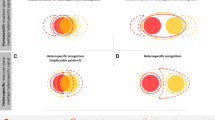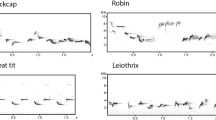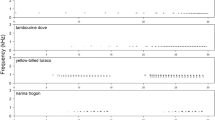Abstract
Ecological segregation and interspecific territoriality can reduce exploitative competition in morphologically and ecologically very similar species allowing their coexistence. We studied habitat use and features, ecomorphology and homo- and heterospecific playback responses in the similar and sympatric Red-and-white Crake (Laterallus leucopyrrhus) and Rufous-sided Crake (Laterallus melanophaius) on the coast of the Río de la Plata, Argentina. We carried out playback sessions with stimuli of both crakes in four habitat types potentially used by them across the four seasons (coastal humid scrub, bulrush, floodable grassland and exotic yellow iris). Crakes were segregated year-round by habitat, with minor overlap: Red-and-white Crakes used bulrush, while Rufous-sided Crakes used coastal humid scrub. Patterns of habitat use were the same when using homo- or heterospecific playback stimuli, and both species responded similarly to homo- and heterospecific playback trials in their selected habitats. Crakes were morphologically distinct and some of their differences can be related to habitat features and resource exploitation: Red-and-white Crakes had longer tarsi and “blunt” bills and inhabited the deeper and denser bulrush, while Rufous-sided Crakes had shorter tarsi and “dagger” bills and inhabited the shallower and more open coastal humid scrub. Habitat use resulting in spatial segregation in these crakes seems to be more related to specific abilities to exploit different habitats than to interspecific competition or interspecific territoriality. Habitat adaptation would be more relevant within large patches of homogeneous and simple habitats selected by each Crake, while interspecific territoriality would gain importance at habitat boundaries with heterogeneous or intermediate conditions.
Zusammenfassung
Ökologische Trennung und vokale Interaktionen zweier sympatrischer Rallen ( Laterallus )
Ökologische Trennung und interspezifisches Territorialverhalten können ausbeuterische Konkurrenz bei morphologisch und ökologisch sehr ähnlichen Arten verringern und damit deren Koexistenz ermöglichen. Wir untersuchten die Habitat-Besonderheiten und dessen Nutzung, die Ökomorphologie und die homo- und hetero-spezifischen Playback-Antworten bei den sehr ähnlichen und sympatrischen Arten Weißbrustralle (Laterallus leucopyrrhus) und Rothalsralle (L. melanophaius) am Rio de la Plata, Argentinien. Dafür führten wir Playback-Sitzungen mit vokalen Stimuli beider Rallenarten und in denjenigen vier Habitat-Typen durch, die von den beiden Arten über die vier Jahreszeiten genutzt werden (feuchte Küsten-Macchia, Binsen und Schilf, regelmäßig überflutetes Grasland und Wasserschwertlilien). Die Rallen blieben rund ums Jahr mit nur kleinen Ausnahmen durch die Habitate voneinander getrennt: die Weißbrustrallen nutzten Binsen und Schilf, die Rothalsrallen die feuchte Küsten-Macchia. Die Art und Weise der Habitat-Nutzung blieb gleich, egal ob homo- oder heterospezifische Playback-Reize gegeben wurden, und beide Arten antworteten auf ähnliche Weise auf homo- und heterospezifische Playbacks in ihren jeweiligen Habitaten. Die Rallen sind morphologisch klar unterschiedlich, wobei einige Unterschiede auf die unterschiedlichen Habitat-Eigenschaften und Resourcen-Nutzung zurückgeführt werden können: die Weißbrustrallen haben längere Tarsi und stumpfe Schnäbel und leben im tieferen und dichteren Schilfdickicht, wohingegen die Rothalsrallen kürzere Tarsi und schärfere Schnäbel haben und die flachere und offenere Küsten-Macchia bewohnen. Ihre Habitat-Nutzung und die sich daraus ergebende räumliche Trennung scheinen bei beiden Rallen-Arten mehr von den jeweiligen Fähigkeiten abzuhängen, unterschiedliche Habitate zu nutzen als von interspezifischer Konkurrenz oder Territorialität. Eine Anpassung an ein Habitat wäre eher bei großen, zusammenhängenden Habitaten relevant, die sich jeweils eine Rallen-Art aussuchen würde, wohingegen interspezifisches Territorialverhalten dann eine Bedeutung hätte, wenn die Habitatgrenzen sehr heterogen wären oder es ausgeprägte Übergänge zwischen den Habitaten gäbe.




Similar content being viewed by others
References
Anderson BW, Ohmart RD (1985) Habitat use by Clapper Rails in the lower Colorado River Valley. Condor 87:116–126
Arballo E, Cravino JL (1987) Nido de Burrito de Patas Rojas, en Tacuarembó, Uruguay. Nuestras Aves 14:21
Areta JI, Depino E (2012) Red-and-white Crake (Laterallus leucopyrrhus). Neotropical Birds Online. http://neotropical.birds.cornell.edu/portal/species/overview?p_p_spp=135636. Accessed 10 March 2016
Cody ML (1973) Character convergence. Annu Rev Ecol Syst 4:189–211
Cody ML (1985) Habitat selection in birds. Academic Press, Orlando
Conway CJ (2011) Standardized North American marsh bird monitoring protocol. Waterbirds 34:319–346
Conway CJ, Sulzman C (2007) Status and habitat use of the California Black Rail in the southwestern USA. Soc Wetl Sci 27:987–998
Darrah AJ, Krementz DG (2011) Distribution and habitat use of King Rails in the Illinois and Upper Mississippi River Valleys. J Wildl Manage 73:1380–1386
Dunning JB (ed) (2007) CRC handbook of avian body masses, 2nd edn. CRC, Boca Raton
Erickson HT, Mumford RE (1976) Notes on birds of the Viçosa, Brazil region. Purdue Univ Agric Exp Stn Bull 131:1–29
Flores RE, Eddleman WR (1995) California Black Rail use of habitat in Southwestern Arizona. J Wildl Manage 59:357–363
Garcia-R JC, Gibb GC, Trewick SA (2014) Deep global evolutionary radiation in birds: diversification and trait evolution in the cosmopolitan bird family Rallidae. Mol Phylogenet Evol 81:96–108
Grether GF, Anderson CF Drury JP, Kirschel ANG, Losin N, Okamoto K, Peiman KS (2013) The evolutionary consequences of interspecific aggression. Ann N Y Acad Sci 1289:48–68
Hartert E, Venturi S (1909) Notes sur les oiseaux de la République Argentine. Nov Zool 16:159–267
Herrera R, Torres Robles S (2012) Comunidades vegetales de la Reserva Natural Punta Lara. In: Roesler I, Agostini MG (eds) Inventario de los vertebrados de la Reserva Natural Punta Lara, provincia de Buenos Aires, Argentina, Temas de Naturaleza y Conservación, Monografía de Aves Argentinas No 8. Buenos Aires, Argentina, pp 35–643
James FC (1982) The ecological morphology of birds: a review. Ann Zool Fenn 19:265–275
Jankowski JE, Robinson SK, Levey DJ (2010) Squeezed at the top: interspecific aggression may constrain elevational ranges in tropical birds. Ecology 91:1877–1884
Johnson RR, Dinsmore JJ (1986) Habitat use by breeding Virginia Rails and Soras. J Wildl Manage 50:387–392
Klimaitis JF, Moschione FN (eds) (1987) Aves de la Reserva Integral de selva marginal de Punta Lara y sus alrededores. Ministerio de Economía de la Provincia de Buenos Aires, Buenos Aires
Kroodsma DE (1986) Design of song playback experiments. Auk 103:640–642
Leisler B (1988) Interspecific interactions among European Marsh-nesting passerines. Acta XIX Congr Int Ornithol 2:2635–2644
Livezey BC (1998) A phylogenetic analysis of the Gruiformes (Aves) based on morphological characters, with an emphasis on the Rails (Rallidae). Philos Trans R Soc Lond Ser B: Biol Scie 353:2077–2151
Losin N, Drury JP, Peiman KS, Storch C, Grether GF (2016) The ecological and evolutionary stability of interspecific territoriality. Ecol Lett 19:260–267
Martin PR, Martin TE (2001) Behavioral interactions between coexisting species: song playback experiments with wood warblers. Ecology 82:207–218
Martin PR, Fotheringham JR, Ratcliffe L, Robertson RJ (1996) Response of American Redstarts (suborder Passeri) and Least Flycatchers (suborder Tyranni) to heterospecific playback: the role of song in aggressive interactions and interference competition. Beha Ecol Sociobiol 39:227–235
Maurício GN, Dias RA (1996) Novos registros e extensões de distribuição de aves palustres e costeiras no litoral sul do Rio Grande do Sul. Ararajuba 4:47–51
Mikami OK, Kawata M (2004) Does interspecific territoriality reflect the intensity of ecological interactions? A theoretical model for interspecific territoriality. Evol Ecol Res 6:765–775
Miller RS (1967) Pattern and process in competition. Adv Ecol Res 4:1–74
Murray BG (1971) The ecological consequences of interspecific territorial behavior in birds. Ecology 52:414–423
Murray BG (1976) A critique of interspecific territoriality and character convergence. Condor 78:518–525
Pagano LG, Jordan EA, Areta JI, Jensen RF, Roesler I (2012) Aves de la Reserva Natural Punta Lara. In: Roesler I, Agostini MG (eds) Inventario de los vertebrados de la Reserva Natural Punta Lara, provincia de Buenos Aires, Argentina. Temas de Naturaleza y Conservación, Monografía de Aves Argentinas No 8. Buenos Aires, Argentina, pp 89–136
Peiman KS, Robinson BW (2010) Ecology and evolution of resource-related heterospecific aggression. Quart Rev Biol 85:133–158
Pereyra JA (1938) Algunos nidos poco conocidos de nuestra avifauna. Hornero 7:25–30
Pigot AL, Tobias JA (2012) Species interactions constrain geographic range expansion over evolutionary time. Ecol Lett 16:330–338
Prescott DRC (1987) Territorial responses to song playback in allopatric and sympatric populations of alder (Empidonax alnorum) and willow (E. traillii) flycatchers. Wilson Bull 99:611–619
Ręk P, Kwiatkoskwa K (2016) Habitat complexity and the structure of vocalizations: a test of the acoustic adaptation hypothesis in three rail species (Rallidae). Ibis 158:416–427
Ripley SD (1977) Rails of the world: a monograph of the family Rallidae. Godine, Boston
Robinson SK, Terborgh J (1995) Interspecific aggression and habitat selection by Amazonian birds. J Anim Ecol 64:1–11
Rosenzweig ML (1981) A theory of habitat selection. Ecology 62:327–335
Rundle WD, Fredrickson LH (1981) Managing seasonally flooded impoundments for migrant rails and shorebirds. Wildl Soc B 9:80–87
Stiles FG, Levey DJK (1988) The Gray-breasted Crake (Laterallus exilis) in Costa Rica: vocalizations, distribution, and interactions with White-throated Crakes (L. albigularis). Condor 90:607–612
Storer RW (1981) The Rufous-faced Crake (Laterallus xenopterus) and its Paraguayan congeners. Wilson Bull 93:137–144
Taylor B, van Perlo B (1998) Rails: a guide to the rails, crakes, gallinules and coots of the world. Helm, London
Winkler H, Leisler B (1985) Morphological aspects of habitat selection in birds. In: Cody ML (ed) Habitat selection in birds. Academic Press, Florida, pp 415–434
Acknowledgments
We thank Federico Brissón Egli, Facundo Di Sallo, Giselle Mangini, Facundo Gandoy, Sol Gennuso and Emilio Jordan for companionship and help in the field. Rodrigo Altamirano helped with the statistical analyses. An anonymous, thorough reviewer provided useful criticism. Sebastian Preisz and Ramiro Comisso provided photos for Gabriel Baloriani’s illustrations. The Organismo Provincial para el Desarrollo Sostenible granted study permits, and all the rangers of the RNPL provided help. The Cornell Lab of Ornithology and Idea Wild supported us with equipment. This research was funded by the Consejo Nacional de Investigaciones Científicas y Técnicas and the Consejo Interuniversitario Nacional. The experiments comply with current Argentinian laws.
Author information
Authors and Affiliations
Corresponding author
Additional information
Communicated by M. Naguib.
Electronic supplementary material
Below is the link to the electronic supplementary material.
Appendices
Appendix 1
Catalogue numbers of recordings of duet trills of Red-and-White-Crake (Laterallus leucopyrrhus; n = 12) and Rufous-sided Crake (Laterallus melanophaius; n = 12) used to prepare playback stimuli (see “Methods” for details). All recordings archived at the Macaulay Library of Natural Sounds (http://www.maculaylibrary.org).
Red-and-white-Crake: 166715, 166716, 166718, 166719, 166726, 166730, 166732, 166736, 218282, 220425, 220427, 220428.
Rufous-sided Crake: 166727, 166728, 166731, 166735, 166735, 166737, 166738, 171001, 171728, 179205, 220356, 220357.
Appendix 2
Museum specimens of Red-and-white-Crake (L. leucopyrrhus; n = 22) and Rufous-sided Crake (L. melanophaius; n = 40) examined and measured for this study. Specimens are held at the IML, the MACN and the MLP.
Red-and-white Crake: IML: 2602, 2605, 2611, 9513, 9606, 12233. MACN: 2503a, 3706a, 4568a, 5415a, 8405, 8812, 9162, 9563, 9631, 9631, 9631, 9631, 35204, 40112, 40245, 43351. MLP: 5891, 5992, 13706, 13707.
Rufous-sided Crake: IML: 2606, 2607, 2608, 2610, 2612, 6967, 6968, 8860, 9398, 10413, 10414, 12853, 13502, 13995, 14997, 15143, 15194, 15195. MACN: 2052a, 2053a, 2633, 7436, 7436, 9291, 9631, 39217, 42141, 42142, 42143, 48383, 56104, 56345, 57561, 58795, 59378. MLP: 2990, 6845, 13710, 13985, 14124.
Rights and permissions
About this article
Cite this article
Depino, E.A., Areta, J.I. Ecological segregation and vocal interactions in two sympatric Laterallus crakes. J Ornithol 158, 431–441 (2017). https://doi.org/10.1007/s10336-016-1397-4
Received:
Revised:
Accepted:
Published:
Issue Date:
DOI: https://doi.org/10.1007/s10336-016-1397-4




